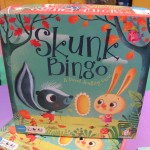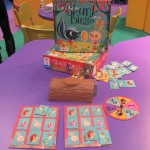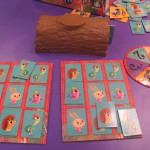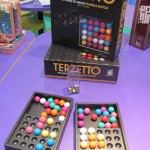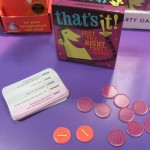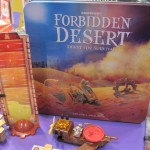 The new One Night app (Android, iOS, and web app) works as an aid for One Night Ultimate Werewolf, providing automated narration for the night time and a timer for the day time.
The new One Night app (Android, iOS, and web app) works as an aid for One Night Ultimate Werewolf, providing automated narration for the night time and a timer for the day time.
The iPad version of Forbidden Desert has finally hit iTunes.
Someone made an app to replace the electronic tower device in Milton Bradley’s 1981 Dark Tower game. The app provides a pretty faithful reproduction of the tower’s graphics and sounds.
Lone Wolf Development has added 5th edition Dungeons & Dragons to the list of games supported in its Hero Lab RPG management software.
Bushiroad is making an online version of its Cardfight!! Vanguard TCG.
- Comments Off on Boards to Bytes
 Last month at the UK Games Expo, GameWright demoed Matt Leacock’s Forbidden Desert, and it does exactly what a good sequel should do.
Last month at the UK Games Expo, GameWright demoed Matt Leacock’s Forbidden Desert, and it does exactly what a good sequel should do.
With a strong immersive flavor and excellent components from GameWright, it brings a new feel from mechanisms the players are likely to know and enjoy. You can almost hear the desert sound track floating across the dunes as you frantically dig. I found the game and it’s excellent production and film-can presentation conjured up a very cinematic feel reminding me of everything from the Mummy, Return of the Jedi, and Indiana Jones. If tense, high theme co-operative games have a place at your table, this comes highly recommended.
Sequels are not a new concept. In the movie world, if you enjoyed the first film, you will return for more of the same. There is less need for scene setting and less time taken to explain the concepts behind the characters and the situations they find themselves in. In the board gaming world this is normally accomplished through expansion sets with true sequels being rare but not unheard of.
Forbidden Desert though, is exactly this: a true sequel to Forbidden Island – more of the same, with a refreshing new twist.
Between two and five players select a role card (each with a different rule bending ability) and work in cooperation to find four pieces of an ancient airship to escape from the Island Desert. The desert tiles are laid out face down and Read the rest of this entry »

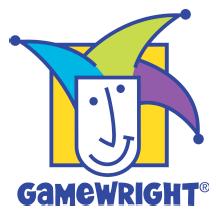 For 2013, Gamewright’s lineup includes nine new games, ranging from preschool to strategy titles.
For 2013, Gamewright’s lineup includes nine new games, ranging from preschool to strategy titles.
Skunk Bingo is for preschoolers and features a spinner, plastic log, bingo-style game boards, and tokens with pictures of various woodland creatures. The point, of course, is to fill one’s bingo board with matching creature tokens. The twist is that while the spinner indicates a number and type of token each turn, those tokens don’t go directly onto a player’s board. Rather, the player is supposed to slip them in to one end of the plastic log, which pushes a corresponding number of tokens—different ones—out the other end. These are the ones that go on the board. Also, skunks are useless. They don’t match anything.
Wig Out is actually a rerelease of an earlier Gamewright card game but with new packaging and cards for four additional characters. The game is played simultaneously, players throwing down their cards onto matching stacks. Stacks, though, can’t be started until one player puts down a pair. A player that has no matching cards is supposed to draw back up to a hand of eight. The winner is the first player to get rid of all their cards.
Chef Pop de Pop also involves a hand of eight cards. In this one, though, the goal is to save as many cards as possible by matching them to the results on popcorn dice in a shaker (the shaker looks kind of like a frying pan or a Jiffy Pop device from before everyone switched to the microwave). Also, one of the dice in the shaker is an action die meant to stir things up. For example, if the action die reads “Pop” then the first person to yell out “Pop” gets a free turn to themselves.
The goal when playing Monster Cafe is to feed as many monsters as possible their favorite meals, while not being stuck with any that are still hungry. It’s a set-collection game with a push-your-luck element. Players can grab monsters earlier, in the hope that they’ll be able to feed them later, or wait until they’ve been fed, with the risk that someone else will grab them first.
In Terzetto, two players go head-to-head, each turn trying to match with three same-colored marbles a pattern set with a shaker. The first person who can’t fit the pattern within their 5 x 5 grid, loses. The game can also be played with a variant, where the three placed marbles must be of different colors and the goal is to get three in a row of the same color.
Combining a marbles-like action game with a miniatures-style fantasy battle game is Cube Quest. In it, two players each get to recruit an army from among 25 cubes representing knights, priests, monsters, and other soldiers. Then, taking turns, they flick the cubes against the defensive structures each other has built, with the goal of knocking the opponent’s king out of his castle. A cube, though, that lands in an opponent’s area has the potential of being captured. Also, different types of cubes have different special abilities. For example, knights can be flicked twice on a turn.
That’s It! is a a trivia guessing game that is part of Gamewright’s Port-a-Party line. It comes with a set of cards, each listing five categories with specific examples. Each round, one player is supposed to read the categories, after which the other players attempt to guess the example. When a player guesses correctly, the reader yells, “That’s it” and hands the player a scoring token.
Iota, previously published by its designer, is a card game most easily described as a cross between Set and Qwirkle. Its cards are square and each has a unique combination of color, number, and symbol. Players are supposed to play the cards in a grid such that in any line either all cards have the same color, same number, and same symbol; or no two cards have the same color, same number, or same symbol; or the cards have the same color and same symbol, but are numbered sequentially.
And finally, there’s Forbidden Desert, a sequel to the company’s Forbidden Island. Like the previous game, Forbidden Desert is played cooperatively, with the players trying to collect artifacts—in this case, components to an ancient flying machine—while fighting the environment. Rather than rising water, however, this game features sand storms and shifting dunes. In fact, the tiles that represent the desert, not only slowly cover with sand markers, making it more difficult to excavate the artifacts, they also move around the board. And while running around the board, shoveling sand, and excavating (flipping desert tiles) the players’ characters are constantly dehydrating, making finding and managing water resources an important element of the game.
Forbidden Desert will be packaged in a tin a bit larger than Forbidden Island but still retail for only $25.
- Comments Off on Toy Fair 2013—Gamewright
Trending
- Massdrop.com
- Oh the Irony—Illuminati Card Game Continues to Inspire Conspiracy Theorists
- Footprints, an Educational Ecology Game
- Home
- USPS Adds Board Game Flat Rate Box
- Baila, the Estonian Drinking Card Game
- Crystal Caste Wins Dice Patent Suit Against Hasbro
- Mirror Game, Red and Blue
- Are Board Games Dangerous?
- Board Games Based on Hindu Mythology
Archives
Most Popular Articles
- Oh the Irony—Illuminati Card Game Continues to Inspire Conspiracy Theorists
- The 20 Most Valuable Vintage Board Games
- The Truth About Dominoes On Sunday in Alabama
- Sequence Game, and Variants
- USPS Adds Board Game Flat Rate Box
- Baila, the Estonian Drinking Card Game
- The 13 Most Popular Dice Games
- Are Board Games Dangerous?
- Guess Who? The Naked Version
- What Happened to the Jewel Royale Chess Set?
Recent Posts
- Toy Fair 2019—Breaking Games
- Talisman Kingdom Hearts Edition
- Toy Fair 2019—Winning Moves
- Toy Fair 2019—Games Workshop
- Toy Fair 2019—Star Wars Lightsaber Academy
- Toy Fair 2019—Stranger Things Games
- Toy Fair 2019—HABA
- Licensing Roundup
- Game Bandit
- 2018 A Difficult Year For Hasbro But Not For D&D Or MtG
Recent Comments
- on Toy Fair 2019—Winning Moves
- on Game Bandit
- on Second Look—Dungeons & Dragons Waterdeep Dragon Heist
- on Crowdfunding Highlights
- on Beyblade SlingShock
- on Game Bandit
- on Game Bandit
- on Watch This Game!, the Board Game Review Board Game
- on Second Look—Vampire: The Masquerade 5th Edition
- on Palladium Books Loses Robotech IP License, Cancels Five-Year-Overdue Robotech RPG Tactics Kickstarter


